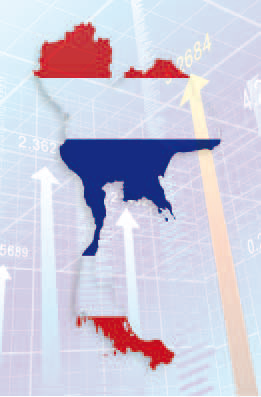Thai Economic Trends after NCPO Period (1)

Source : http://d3934473.u104.greatscottdesign.com/wp-content/uploads/economic-dev.jpg
Throughout the past decade, the economy of Thailand had to continuously deal with different situations caused by political conflict, world economic crisis, social problems, and natural disasters, resulting in relatively high fluctuation in the economy of Thailand. Thai politics is currently approaching a major transitional period. A point to ponder on is the resulting Thai economyonce the power transitional period has ended and/or in the intermediate term(the next 3-5 years). The followings are factors as well as Thai economic trends after the NCPO period that I have analyzed and anticipated.

The first trend:"The growth of cross-border economy"
The existing cross-border economy will expand further and the new economic area as well as the investment promotion district at the border will emerge. The cross-border trade figure between Thailand and four neighboring countries(Malaysia, Cambodia, Laos, and Myanmar)in 2013 accounted for THB9.2 hundred billion or valued at 6 percent of total international trade value of Thailand, and it?s expected that the cross-border trade will peak at THB1 trillion in 2016.
The crucial factors leading to an expansion of the cross-border economy are(1) the geographical advantage of Thailand as it is located at the center of the region and its boundary is connected to a number of neighboring countries in a lengthwise distance with trade channels along the border line at more than 89 locations;(2) cooperation for becoming AEC in late 2015 - which would increasingly free the movement of goods, services, investment, and skilled labor , leading to an ascending economic connectivitywithin the region, the expansion of neighboring economies which will also raise the demand for goods from Thailand, and the expansion of tourism within the region which will increase travelling of cross-border tourists;(3) cross-border economic development policy of NCPO which will provoke the movement of the production base towards the border area, labor-intensive industries in particular; (4) the development of infrastructure to connect the transportation system which will lower the production and freight cost from the border, providing greater convenience for transportation to travel to the border area, and expediting the flow of growth towards the border.
The second trend:"A shortage of skilled or vocational labor"
The demand for mid-level skilled labor has gone up while the number of people with a vocational education is insufficient to satisfy this need. People with a bachelor?s degree have to acquire a job requiring knowledge lesser than what their qualification has allowed them to gain. Factors causing a labor shortage consist of the(1) restructuring of the economy to be one which is higher in value and has made the labor-intensive industrieslikely to be uncompetitive and boosted the requirement for middle and high level of labor;(2) mismatch of demand and supply for labor? mid-level skilled labor needed for feeding more jobs to industries would be 50 percent of demand of new labor each year. The Vocational Education Commission had set the target to increase the ratio of vocational education to general education to be 51 per 49 for the academic year of 2015 butonly 30 percent of junior high school graduates chose to advance to vocational education and this figure is likely to go down.The major obstacle is the number of people studying in general education which has gone up and those with vocational education mostly continue their studies at a higher level since there is no career path for those who have graduated from vocational school and those who have taken up vocational education are badly perceived.
The third trend:"An increase in labor hiring cost"
Employers will have a higher cost of hiring labor due to a more severe shortage of labor especially unskilled labor coupled with the demand for labor protection and welfare, leading to a higher cost of labor welfare arrangement. Major factors causing an increase in employment cost are(1) alien workers? exodus due to greater expansion in the economy and investments in neighboring countries, resulting in higher needs for labor in these countries; (2) regulating alien workers to prevent and suppress human trafficking since Thailand was ranked in the bottom tier or?Tier 3" in the US Government Annual Human Trafficking Reportwhich pressured Thailand to speed up on the process of resolving its alien workers problem;(3) Social Security Fund (SSF) has lower financial status as the payment for old-age gratuity and pension is likely to rise and it is anticipated that SSF will encounter a financial stability problem in the long run. However, the Social Security Office has currently studied approaches for resolving the mentioned problems; for example, revaluing the rate of contribution in case of old-age benefits, extending the period of contribution paymentfor pension entitlement from 15 years to20 years therefore making it possible that employers will have to pay more in terms of their contributions to SSF.
The four remaining Thai economic trends post NCPO period will be presented in the next article.
Kriengsak Chareonwongsak
Senior Fellow at Harvard University?s Center of Business and Government.
kriengsak@kriengsak.com, http://www.kriengsak.com
Source : http://issuu.com/amthaipaper/docs/amthaipaperissue0081




